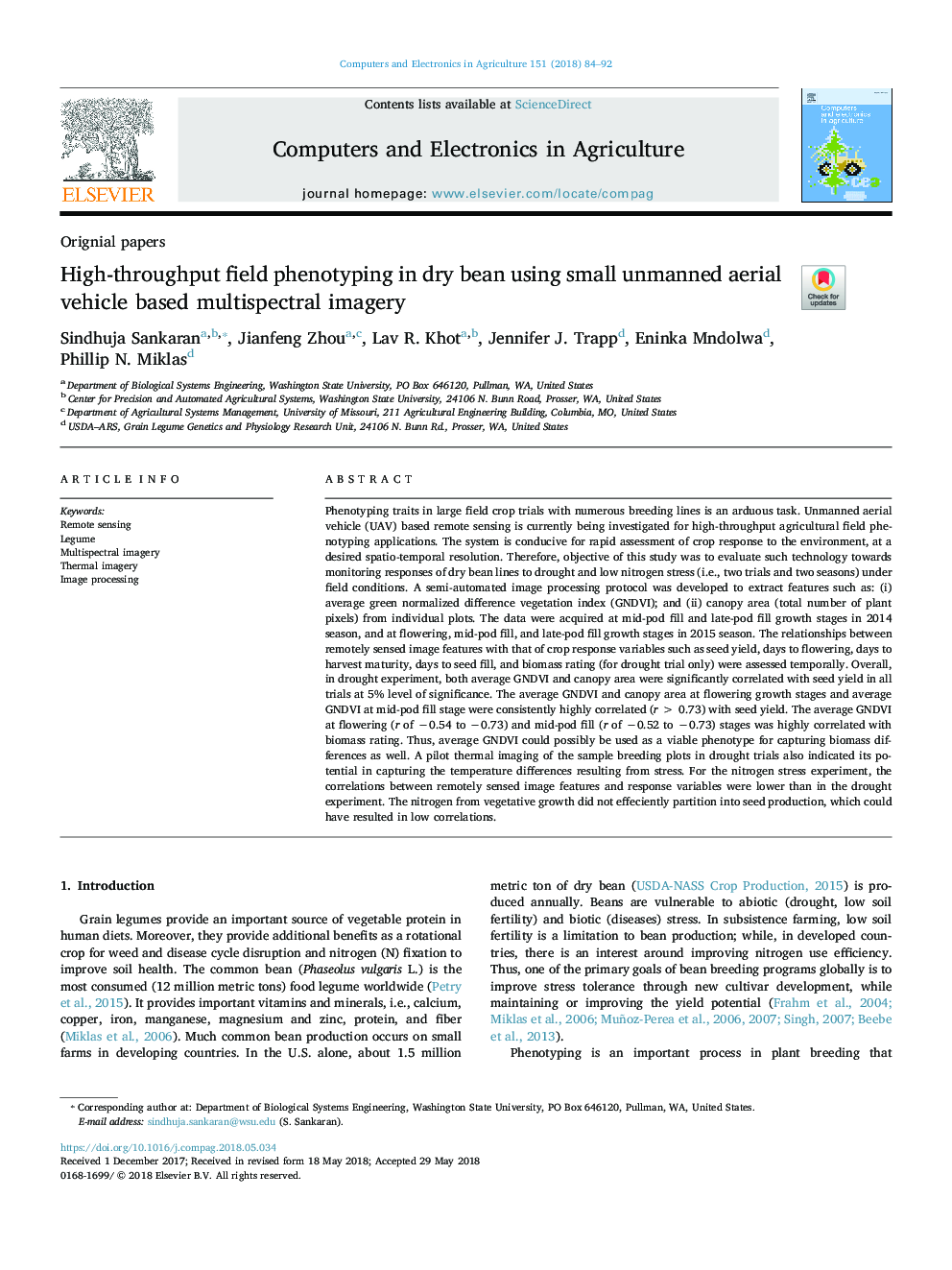| کد مقاله | کد نشریه | سال انتشار | مقاله انگلیسی | نسخه تمام متن |
|---|---|---|---|---|
| 6539328 | 1421097 | 2018 | 9 صفحه PDF | دانلود رایگان |
عنوان انگلیسی مقاله ISI
High-throughput field phenotyping in dry bean using small unmanned aerial vehicle based multispectral imagery
ترجمه فارسی عنوان
فنوتیپ های زمینه ای با کارایی بالا در لوبیای خشک با استفاده از عکس های چند بعدی چند رسانه ای مبتنی بر وسیله نقلیه هوایی بدون سرنشین
دانلود مقاله + سفارش ترجمه
دانلود مقاله ISI انگلیسی
رایگان برای ایرانیان
کلمات کلیدی
سنجش از دور، لوبیا، تصاویر چند بعدی، تصاویر حرارتی، پردازش تصویر،
موضوعات مرتبط
مهندسی و علوم پایه
مهندسی کامپیوتر
نرم افزارهای علوم کامپیوتر
چکیده انگلیسی
Phenotyping traits in large field crop trials with numerous breeding lines is an arduous task. Unmanned aerial vehicle (UAV) based remote sensing is currently being investigated for high-throughput agricultural field phenotyping applications. The system is conducive for rapid assessment of crop response to the environment, at a desired spatio-temporal resolution. Therefore, objective of this study was to evaluate such technology towards monitoring responses of dry bean lines to drought and low nitrogen stress (i.e., two trials and two seasons) under field conditions. A semi-automated image processing protocol was developed to extract features such as: (i) average green normalized difference vegetation index (GNDVI); and (ii) canopy area (total number of plant pixels) from individual plots. The data were acquired at mid-pod fill and late-pod fill growth stages in 2014 season, and at flowering, mid-pod fill, and late-pod fill growth stages in 2015 season. The relationships between remotely sensed image features with that of crop response variables such as seed yield, days to flowering, days to harvest maturity, days to seed fill, and biomass rating (for drought trial only) were assessed temporally. Overall, in drought experiment, both average GNDVI and canopy area were significantly correlated with seed yield in all trials at 5% level of significance. The average GNDVI and canopy area at flowering growth stages and average GNDVI at mid-pod fill stage were consistently highly correlated (râ¯>â¯0.73) with seed yield. The average GNDVI at flowering (r of â0.54 to â0.73) and mid-pod fill (r of â0.52 to â0.73) stages was highly correlated with biomass rating. Thus, average GNDVI could possibly be used as a viable phenotype for capturing biomass differences as well. A pilot thermal imaging of the sample breeding plots in drought trials also indicated its potential in capturing the temperature differences resulting from stress. For the nitrogen stress experiment, the correlations between remotely sensed image features and response variables were lower than in the drought experiment. The nitrogen from vegetative growth did not effeciently partition into seed production, which could have resulted in low correlations.
ناشر
Database: Elsevier - ScienceDirect (ساینس دایرکت)
Journal: Computers and Electronics in Agriculture - Volume 151, August 2018, Pages 84-92
Journal: Computers and Electronics in Agriculture - Volume 151, August 2018, Pages 84-92
نویسندگان
Sindhuja Sankaran, Jianfeng Zhou, Lav R. Khot, Jennifer J. Trapp, Eninka Mndolwa, Phillip N. Miklas,
